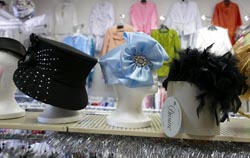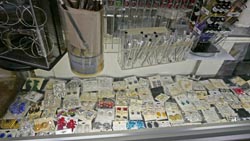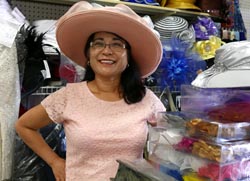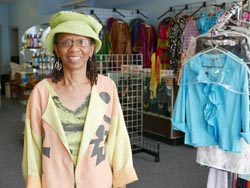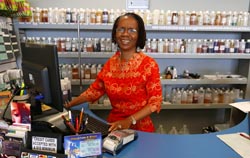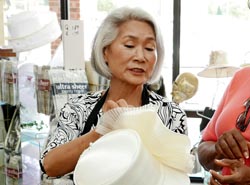Living in Style: The Language of Hats
By Laura Marcus Green
The saying is, and it's true—
a lady is never dressed without a hat.—Aldreamer Smith, Sensational Seniors,
Dr. Leo S. Butler Community Center

Service for all Seasons: The Business of Selling Hats
The three milliners interviewed for this project have each plied their trade over several decades, accumulating valuable knowledge and their own reputations and clientele through the years. Savvy businesswomen all, these milliners know their target markets well and play their strengths accordingly. Tony Aguirre of Variety Fashions knows of the other milliners in town, but observes that they do not necessarily communicate with one another. She feels that each business owner has her own personality, which is reflected in her inventory and business practices. Yet even with the differences among the three shops, some common themes emerged among them.
The Heart of the Business: Customer Service
Some hat wearers make the rounds among the different boutiques, while others find the one that is most to their liking, developing lasting relationships with the proprietors and staff at their favorite shop. Milliners accompany their customers through life's seasons, from weddings, baptisms, funerals, and other occasions when people wear hats. Often, a sense of intimacy grows between milliners and their customers, similar to what one might experience in a beauty parlor. Nomzamo Iyanu reflects on her business philosophy:
When working with customers—of course, businesses need sales to survive. But the way I see it, we develop relationship with customers. And when you develop a positive relationship, customers will come and do business with you. And they will refer others to you. And those referrals are very important. So, it's like we develop relationship, we have history. You know, they'll tell me something about a family member, and we know when they're retiring, or a member of the family is graduating, you know, grandchildren and things like that. So, it's not just about selling goods, you know, you develop a relationship. And people who like to go to the mall, they don't have that kind of atmosphere in the store. The sales rep is nice to you, but after that sale is done, that's it. In a boutique like ours, we try to develop relationships because we want customers for life. Not just a nice big sale, or a couple of sales, you know. So that's how we look at it.
How does Nomzamo go about cultivating customer relationships? She explains, "Well one thing is, I like what I do. I'm having fun. . . all these years, I've been having fun. And when you like what you do, people can see your sincerity."
Tony Aguirre would agree. Her love of her work keeps her going, and her customers are at the heart of her passion for her business. She observes, "When I'm sick, I can't stay home. I like to see the people. I can't just be sitting down and doing things around the house. I've got to go see my friends at the store! They'll be coming!"
Because of her specialty in church wear, the majority of her customers are older women. Tony feels that they have really taught her the business. She has learned much about their culture in order to carry the clothing and accessories they need for church and other occasions. She feels a special connection to elders. Tony reflects, "They are just attached to me, and sometimes I feel like they're my aunts, they're my mothers. And so, I want them to be treated with dignity. They are somebody, you know?" In her many years with Variety Fashion, Tony has never advertised; her clientele finds her via word of mouth. She says, "So I think that service is very important to the customer. Service is the number one reason that people keep on coming here."
One key ingredient in building good relationships is patience and taking the time to work with customers so that they are satisfied not only with their purchases but also with their experience in the shop. This may be especially true with older customers, who may not be in as much of a hurry or who might require more time or help trying on clothing. During research in Variety Fashion, it became clear that Tony Aguirre takes as much time as is needed with her customers, even up to an hour or more per person on occasion. The time spent with each customer may depend on how well Tony knows her, or the occasion for which she is shopping. Tony observes:
I don't always know everyone who comes in here. But I have to learn about their sense of fashion when they do. So I provide new customers with a lot of clothes to try on. I like my regular customers, because I know their sense of style and we can usually find something for them quickly. So it's easier to provide for regular customers than newer customers. Sometimes regular customers come into the shop looking for something for a particular occasion. I like it when customers come in and, say, "I need something in this color for this occasion." So then I can just concentrate on one color and it's easier for me. But when they say, "I want to buy a suit," that means I have to bring out outfits in all different colors to show them, because I don't know exactly what they are looking for. That's when I need to take more time with them. But you always have to be patient with the customers!
Nomzamo's does a lot of special orders for customers who come in seeking attire for graduations and weddings. They might be the mother or the aunt of the bride or groom. People often come in for special occasions based on referrals. Nomzamo always asks new customers who told them about her shop. Since Nomzamo's is a boutique, her customers are prepared to pay a little more for high-quality wear and the customer service to match.
Nomzamo puts new employees through a nine-day training in order to uphold the boutique's reputation for quality customer service. She has developed her own set of hard-won rules and practices, learned over the years. She observes, "I learn by errors, by living." The training is on-the-job and entails working one-on-one with each new employee. Nomzamo teaches by example. She talks about each transaction, showing the do's and don'ts to help her staff improve on each sale or encounter with customers. The way staff answer the phone is one aspect of the training. Nomzamo teaches her staff to say, "Thank you for calling Nomzamo's. How may I help you?" The "thank you" is important because people have choices. They could have called or gone to another store. Nomzamo believes that customers come to her shop because they have heard about the service.
In addition to the practical how-to lessons, there are also strategies for maintaining positive relationships with customers, such as steering clear of conversations about politics or religion. Employees may listen attentively and empathetically when people broach these sensitive topics, but offering one's own opinion runs the risk of alienating a customer. Like Tony Aguirre, Nomzamo believes strongly in taking time with customers. She observes:
We're interested in all of our customers. So we make eye contact, we smile. We sincerely want to know if we can serve you. And I tell people who come to work here, "If you can't serve, this is not the place for you." Because we help people in the dressing room—you saw how I was helping out the lady. We undress them—unless they don't want that assistance, then we won't give it to them. This is what we do, we serve.
But that's the nature of the business. That's part of it. You know, you spend that time, let customers know that you're willing to take your time and help them. Whether they buy something or not, you spend that time and let them know that you're willing to work with them.
Another key element of good customer service and sustaining relationships is developing trust. An encounter at Four Seasons sheds light on this process. Mu Kyong "K" Dickerson has trained her employees not to give their opinions when customers are trying on hats or other apparel. That way, if a customer is later dissatisfied with her purchase for any reason, she cannot come back and say, "You told me to pick this one." Rather, K and her staff try different hats and outfits together, ultimately leaving it in the customer's hands to choose what looks best. On this occasion, a customer was in search of a blue hat to go with a particular outfit. The customer tried on several hats and was deliberating over which one to buy. K's employee shared that one of the hats under consideration was less expensive than the others, to which the customer replied, "You shouldn't tell me that!" The saleswoman explained that she hoped if she helped her in this way, the customer would come back. These interactions have the potential to build a foundation of trust and loyalty over time.
Milliners walk a fine line between offering guidance and stepping back to let the customer decide. Like K Dickerson, Nomzamo Iyanu teaches her staff to refrain from offering opinions when customers try on hats or other apparel and ask for feedback. The milliners stock their shops with items they think will appeal to their customers. They also have catalogs on hand for placing special orders. When a regular customer comes in, milliners might select certain hats for them try on, especially when someone comes in seeking a hat to match an outfit or for a certain occasion. But when customers try on a hat, milliners put the accountability back in the customer's court. It's a delicate dance, but one they know well. Nomzamo Iyanu reflects on the importance of striking that balance:
I know a lot of times customers will pick out an outfit and it may not look a certain way on them that I think is appropriate or right. And they'll ask my opinion—"Well what do you think about it?" And I'll ask theirs, "What do you think?" You know, I am aim to please. Now, my taste and your taste may be a little different. So we listen to what they say. And sometimes the outfit is just absolutely gorgeous and I'll say, "Look at you. I don't have to sell this outfit to you. You can already see this." You know, those little things, those statements are enough. And they could see the sincerity and honesty. And if something is too big, we tend to say, "Well it's a little full. What do you think about it?" You know, we'll give our opinion. But it's just slight, nothing heavy. Because some people are in denial, you know, if they need to wear a size 18 and they're in a 16, But then, again, you handle it, "How do you like it?" And they hear the sincerity and they'll come back later and say, "You know what? That was perfect. When I walked in the door, and everybody just said, 'Oh you look absolutely gorgeous, you know—the hat, the shoes, everything.'" So, that makes a difference, just being sincere and honest. You know, you can be gentle, but they come back when they trust you. In the end, they really trust what you say.
Tony Aguirre has learned the importance of knowing when to offer her opinion and when to hold back. Typically, she tells people whether she thinks a particular hat works. Some of her customers get upset when she shares her thoughts, so she tries not to say very much in certain situations. Instead, she asks them kindly, "What do you like?"
Tony has also fine-tuned her listening skills when talking to her customers about their health issues. Although women wear wigs for different reasons, hat and wig sellers tend to be knowledgeable about cancer and cancer treatment, and familiar with their customers' health issues. This is a part of the friendship that grows among the milliners and their customers in general, but since wigs and hats can help cover a cancer patient's head, there is additional specialized knowledge entailed. Women who lose their hair during chemotherapy often turn to hat and wig shops to bolster their appearance and self-confidence. K Dickerson of Four Seasons Hat & Wigs knows how to trim a wig and how to care for hair as it is growing back after chemotherapy. Tony Aguirre of Variety Fashion relates that some customers openly discuss their medical situations with her, while others prefer not to speak about them directly. She has learned to be attentive to this distinction and respond accordingly.
From the above, it is clear that all three milliners interviewed for this project understand that listening and tuning in to their customers are among the most critical skills in customer service. Tony Aguirre observes:
It's not just about selling the garments, sometimes. I hear their problems, too. Because I guess we women like to talk to each other people about our problems. So sometimes I listen to my customers' problems. But the Bible shows, exchanging our problems is a good thing. We women need to let out whatever is in our hearts, so sometimes it's a full house over here! This little store can be a full house, and it's fun! You know? Because sometimes, one person comes in, and then another person just comes in. Sometimes they already know each other. So it's just like a family fun day!
Developing relationships with customers begins at the level of one-on-one interactions. It is not surprising that customers discuss their life issues or situations with the milliners, since often they are in the shop precisely because they are seeking an outfit for a wedding, graduation, or funeral. The clothing becomes part of these occasions, these life passages. Having a meaningful face-to-face encounter with someone who knows and cares about you, and who listens, is an increasingly rare experience in an era of high-speed, less personal communication.
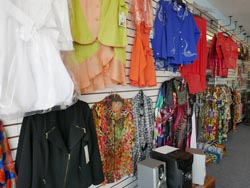
In addition to being attentive listeners, the three milliners consulted for this project also seem to nurture an inviting ambiance in their shops, where customers may not only feel welcome to talk with the staff but also with one another. Some customers may plan shopping trips together, but most often customers just happen to coincide. They may not know one another, but they may end up engaging in a group conversation while shopping at the same time. Nomzamo Iyanu reports that her boutique is considered a destination by some of her regular customers. She notes:
If it was bigger and I had an area where I could put out books and a chair and a table, girl, let me tell you, they would be in here! Because we have people that come in here and just say, "It feels so good when I come in here and just spend some time." I mean, people literally say that. They don't say that when they go to Dillard's and those big stores, you know? You have to create that atmosphere. When you to go to a restaurant, you expect to sit a while, but not at the store. But people come in here, and they love it. "It feels so good, it feels so good," the customers say. That's the energy that we put in here. I play certain kinds of music. We have certain kinds of aroma therapy here. Because I have to feel good, too, while I'm here. You know? So I want you to feel good when you come in. But people actually acknowledge it, saying, "I like to come here, I could stay here all day." People just come and share, and share and share. So, that's good.
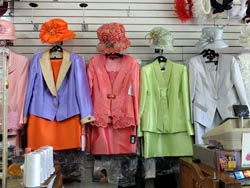
Relationships with longstanding customers may extend to their families. In addition to the women who wear hats, some men also shop for gifts for their mothers, grandmothers, or wives. This is also true of customers' daughters and granddaughters. Especially where women are regular and longstanding customers, milliners can ably help family members select the right hat. Because children and grandchildren have grown up learning about their mother's or grandmother's taste in hats, or since they know their wives so well, they may not need help picking out a hat. Some family members give money to the women in their lives so they can pick out their own hats. Tony Aguirre reports that others like to surprise loved ones with the gift of a hat. She says, "Because they've already been that regular customer, we know their size, I know their fashion sense and what they like. So, when their children, grandchildren, or husbands come in and they tell me what colors they are looking for, I know their aunts' and their mothers' fashions, so I can represent them. People who come in shopping for a gift usually leave feeling happy with their purchases."
Sometimes milliners help select hats for their customers when they are unable to get to the shop themselves due to illness, age, or lack of transportation. In all of these instances, store owners relax their "no returns" policy, although it is seldom needed since they and the families know their customers so well.
When a customer passes away, the family often turns to their loved one's milliner to find the right outfit for burial. This service is a sacred trust and a comfort to bereaved families. Women who wore hats in life are often buried wearing a hat. By special arrangement with undertakers, milliners customize hats by trimming them in the back, so that they fit into a coffin. Nomzamo Iyanu relates that her customers' daughters sometimes begin shopping at her store after their mothers pass away, in order to maintain that connection.
Flexibility and Satisfaction: The Name of the Game
Hats, dresses, and suits are a significant investment, which speaks to their importance in people's lives. The milliners consulted for this project all offer layaway plans. Many of their customers save money to buy special outfits and come in ready to make a purchase. In addition to dresses, suits, and hats, milliners carry more modestly priced "bread-and-butter" items, such as nail polish, hose, costume jewelry, and other accessories. By offering all of the necessities, milliners not only provide a one-stop shopping experience, but they cover an economic spectrum.
The milliners have learned to hone related skills like customizing, embellishing, and repairing hats and accessories. Occasionally, K Dickerson of Four Seasons sews decorations onto her hats in order to make them one-of-a-kind. Tony Aguirre's inventory at Variety Fashion tends towards the "blingy" side, to suit her customers' tastes. Even so, customers sometimes ask Tony to add more embellishments to their purchases. This is a skill she has learned over the years. She sometimes adds a flower, pin, or pendant to a hat. Customers may also bring their own embellishments when they wish to alter a hat as it came from the manufacturer. Tony assists with this process, pinning or gluing pendants or additional rhinestones onto the hats. She enjoys this work, as it makes her feel like a craftswoman. She says, "When you do this work, you have to be versatile, you have to learn how to sew a little bit. You have to know how to do decorations. Sometimes my husband helps me with soldering earrings that are broken. We have to learn all of that, so he's a tremendous help, too!"
Versatility is another tool in the milliner's kit. Being flexible helps adapt to changing times, like when there are shifts in the economy. Both K Dickerson and Nomzamo Iyanu adjusted their inventories in response to the 2008 recession. K Dickerson reports that she once carried fine designer hats in Four Seasons, but that in the years following the recession her customers stopped wearing these more costly pieces. Likewise, Nomzamo no longer stocks the high-end designer hats she once ordered. Further, she now sells formal wear only on a special-order basis, as opposed to keeping it in the store as part of her regular inventory. Since the recession, she has had to acclimate to the new economy rather than "keep doing the same thing, and failing."
Even with the ups and downs, the milliners have remained in the business, continuing to find much gratification in their work. The milliners' considerable passion and their devotion to their customers has sustained each of them over decades. Tony Aguirre takes good care of her customers, as her livelihood depends on the people. Yet, salesmanship aside, this is happy work for her. She reflects on the personal rewards of her work:
There are days when people leave the store happy with their new clothes. And sometimes, they wear their clothes to a function and people admire their outfits. And they'll come back and tell me about it, and that makes me happy. So, I'm loving it. People come in here, and they try on hats and suits, and they're happy, so I'm happy, too. Because some of them look gorgeous when they put on the clothes and hats! So that's my desire, to make other people happy. I'm enjoying the work I'm doing. I love to dress my customers. I myself don't wear this style of clothing. But when my customers put on the hats and suits, it makes me so happy! So, you know, it's the way they dress and when they dress in their traditional clothes, it just fills my heart with joy. I'm sure if your mother were a hairdresser, when she fixes a customer's hair, and the customer says, "Oh, my hair came out nicely," and then your mother will be so happy, right? It's the same for me.
Nomzamo likewise takes pleasure in providing her customers with just the right outfit. She shares,
You know, being in business all these years, the most gratifying moment for me is when a customer tells me, "This is exactly what I was looking for." You know? I might not have seen what she was seeking before and she hadn't seen it before, but she's searching for a particular style. And then we get out the manufacturers' books and start looking. Or else, it may already be in the store. And the customer will say, "This is it." Because when a customer says that, you know the planning and the pre-planning that went into it, and the money that they had to save for it, and all of the thought and creativity that went into it, and then to find it. You know, that's gratifying.
While customer satisfaction may be the most compelling factor driving sales and maintaining long-term relationships, it is ultimately a two-way street for the milliners. In furnishing their customers with the hats and other attire they are seeking, the milliners are helping equip them for life's occasions, big and small.
A Natural Calling: Three Baton Rouge Milliners
None of the milliners interviewed for this project expected to find themselves in the apparel trade. Each found her way to this work serendipitously but once there, discovered a natural calling.
Tony Aguirre, Variety Fashion
Tony Aguirre never imagined herself going into the millinery business. She grew up in a rural farming town in South Korea, where clothing was not a particular focus in her life. Her husband, Arturo Aguirre, a native of south Texas, was in the military in South Korea when they met. After moving to the United States in 1979, the Aguirres lived in various locations before settling in Baton Rouge, where they have made their home ever since.
Once their three sons were in school, Tony began to think about working outside of the home. As she made this transition, she thought she would be best suited for a position in business. When finding a job proved difficult, she went to work for a friend, selling knick-knacks at a flea market. She found that she liked sales and opened her own storefront business, Variety Fashion, in 1997. The store is in its original location, in a small shopping center on Government Street. When Tony launched her business, she sold all manner of merchandise, from beauty products to children's clothing. Hence the name, Variety Fashion. As she came to know her clientele, she found her niche in women's "church wear," for which she has long been known.
Tony's husband Arturo takes an active part in the business. He often comes to the shop at the end of his work day at the federal highway department and on weekends to keep Tony company and help out where needed. He has been supportive of the business from day one. When the Aguirres first started out, they learned the trade by visiting regional garment districts, especially in Houston, Texas.
After so many years in the business, Tony knows her customers' tastes well, and is now consulted by the manufacturers about what will sell in her shop. These days, the traveling salesmen come to her; she no longer travels to markets to buy her merchandise. Reps from the manufacturing companies come twice a year, bringing clothing for spring and summer, and then autumn and winter. The reps tap the experience of seasoned milliners like Tony, leaving samples of prospective designs with them, and gathering feedback on colors, decorations like buttons and other notions, sizes and other aspects of the clothing. The manufacturers incorporate the milliners' suggestions into their clothing lines. Tony reports, "Sometimes, they say, 'Look, we did exactly what you told us to do!' We women know the designs we want. Sometimes the designers are all men." Input from the on-the-ground businesswoman is invaluable to the manufacturers.
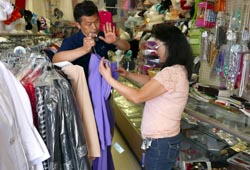
Since she specializes in church wear, Tony's customers tend to be older women, of whom she is especially fond. Through her business, she has come to know her customers and their culture on a personal basis. She takes the time to visit and talk to them about their problems and life situations, in addition to outfitting them for church and all manner of other occasions. Tony takes special care of her elder customers, walking them to their cars to ensure their safety and checking up on them when they don't pick up a special order on time. She believes that this personal attention, the shop's welcoming ambience, and her selection of "blingy" but reasonably priced attire are what keep her customers coming back year in and year out, some from out-of-state locations.
Tony is concerned about what will happen when the older generation is gone, as they are the keepers of the tradition of wearing formal suits and hats to church and other special occasions. Tony loves to see her customers enjoying their clothes. Making them happy is her motivation in the work she does. She observes about her career, "That's why I like this job! As long as the customers are here, I'm happy. But when I have no customers, I have my personal time." During quiet moments, she keeps the shop organized and straightens up right away when she has waited on a customer and there is a pile of clothes to put away. When there have been a lot of customers in the store and she has been pulling out a lot of clothes for people to try on, she feels a sense of satisfaction. Her legs might hurt and her body might be low on energy, but she feels "a good tired" at the end of the day.
Nomzamo Iyanu, Nomzamo's Boutique
Nomzamo Iyanu's apparel and hat business began as a weekend flea market booth that blossomed into a brick-and-mortar store when the insurance company for which she worked relocated out of town and she stayed on in Baton Rouge. In business for over thirty years, Nomzamo has built a loyal clientele based on high standards of customer service and a unique inventory.
By design, Nomzamo caters to a high-end clientele. With customer service as a hallmark of her business, Nomzamo puts all new employees through a nine-day training to ensure that they maintain her high standards. Nomzamo observes that the long-term customer relationships she and her staff cultivate distinguish the intimate experience in her boutique from the less personal dynamic at large chain department stores.
Nomzamo's inventory combines classic church wear, African attire, and boutique clothing, setting her apart from other shops in the area. Nomzamo explains that her customers want a certain look. "They come to our shop because we don't have everything that other stores have. So they're looking for 'different' when they come to Nomzamo's. They're looking for something different, they're looking for something creative, something that's going to let them stand out. So, that applies to most of the women who come, not just the preachers' wives or the first ladies."
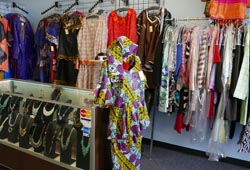
Since she carries African attire, Nomzamo has learned to tie a head wrap. She teaches her staff and customers to wrap the head scarves that come with African outfits. Nomzamo considers an African outfit incomplete without the head wrap. She has returned outfits if they arrive from the manufacturer without them, as she knows she will be unable to sell the outfits otherwise.
During African American History Month each February, many local churches hold one or more services to which congregants wear African clothing. For this and other African American heritage events, such as Juneteenth, Nomzamo's offers trunk shows featuring African clothing. She also helps coordinate African and African American cultural programs, including an annual Kwanzaa celebration. One of her life's missions is to make people aware of Kwanzaa and of their African roots.
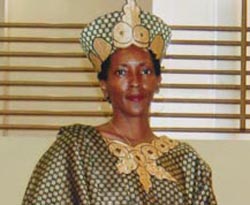
Reflecting on her childhood memories of hats, Nomzamo thinks of her grandmother, who never went to church without a hat. Nomzamo's grandmother instilled in her a taste for distinctive styles and for standing out from others—an aesthetic Nomzamo maintains to this day, both in her own attire and her shop inventory. She remembers a store in Opelousas, Louisiana, Abdalla's, where her grandmother shopped for special attire. In contrast to other shops in the area at that time, this business served Black customers. However, it did not allow them to try on the clothing.
In addition to clothing and accessories, Nomzamo's carries body products such as oils and soaps, and an array of scented oils that customers can adapt to their preference, sometimes based on aromatherapy. Considered an expert on nutrition and wellbeing, Nomzamo is often consulted by her customers about grassroots health care and remedies. Nomzamo's is something of a social hub, where customers come for clothing, counsel, and all manner of information. Reflecting on her more than thirty years in the millinery business, Nomzamo believes that sharing her knowledge is among the most important services she offers, tempered with generous measures of honesty and humility. She reflects on the qualities she has learned to embody over the course of her career:
First of all, it's important not to act like you know everything. Be humble. If you don't know the answer to a question, then say, "I have no idea, but you know what? We can do this together." You know? Because the customers expect us to know. And sometimes when you're under that pressure, you feel like, okay, I've got to give out some answer. But you have to search yourself, be humble, and be honest. People respect the honesty. They respect the humbleness. You know, and they'll come back. If you really don't know, say "I don't know. I have no idea." So being humble and being honest is key.
People really appreciate you that way, and they know when you're lying. If they don't know when you're lying, maybe the next day, they'll think, ah, she doesn't know what she's talking about. Somewhere in that conversation, it's going to come out, you know? So, that's how I see it. Does this approach work? It's been working for me so far.
And sometimes I do know the answer. A customer will ask, "What color shoes should I wear with this outfit?" And I'll say, "Silver. Silver goes with a lot of stuff. Or clear shoes." You know? Especially if they have an outfit that's a particular color, like purple or lilac, and sometimes you can go to the store and find purple and lilac mixed up together in a shoe. But what would be easier to wear with a lilac or a purple suit? Clear or silver shoes, with a clear or silver bag. Simple stuff like that—if you know it, it's okay. But when you don't know, don't give people a way-out answer just to sound good. "I'm Nomzamo, I know this, I've been selling clothes for thirty years, so therefore I must come up with the right answer." No! Mm mm.
Because they have an opinion, and they already have something in mind, an idea of what they are looking for. So you can confirm their idea for them when you agree. But if they ask, then you start looking for the colors that they have in mind. I'll say, "Well let's see, let's see. Let's put this color with this . . . what do you think?" "Mm, it's not flowing for me, but is it flowing for you?" And if it's flowing for them, who's outfit is it?
One thing I've learned is that some women come in here with an idea of what they want. And then you have some who don't have a clue, and you have to guide them every step of the way. At the same time, you have to be humble because, if you know how to help them, you can't be arrogant with your knowledge. You know what I'm saying? You tenderly share. You tenderly provide that information. "Oh no, I don't think this would go well, but you see, this color, it blends, it highlights, and so on." Just be humble and giving in the smartness of your information. It's received better that way, you know? And people learn. Always try to be in a teaching mode, or in a helpful, serving mode. That's what I have found.
Mu Kyong "K" Dickerson, Four Seasons Hat & Wigs
Mu Kyong Dickerson, known as K to her customers, has lived in Baton Rouge since 1991. She found her way to the millinery business when her children began attending school and she was seeking work outside the home. For her first job, she washed dishes at a friend's restaurant during the lunch shift. After K had worked in the restaurant for a short time, a cousin encouraged her to find work that made the best use of her talents. When the hat and wig shop next to the restaurant where she worked went up for sale, her friend who owned the restaurant urged Kyong to consider buying the business, saying, "You could do this." With financial backing from her cousin and support from her husband and friends, K opened the Four Seasons Hat & Wigs shop in 1994.
Previously, while living in Mississippi, she had befriended a Chinese woman who owned a Hallmark franchise and who taught Kyong about working in retail. With no previous experience in the millinery business, Kyong taught herself how to build her inventory by attending shows in Houston, by watching the news and old movies, and looking through magazines. Looking back over her years in business, she attributes her success to the good teachers she has had along the way—her two friends in retail who trained her.
K also believes she has an innate "sense in her eyes" that guides her inventory selection. She has a gift for distinguishing among different colors and shades, which helps her put together outfits and provide guidance for her customers. Often, customers arrive at her shop with a dress or suit in hand, seeking a hat to complete the outfit. K hangs the garment on hooks behind the sales counter and tries different hats until the customer finds the one that works. Since most of her hats and dresses or suits come from the manufacturer as separates, K never quite knows how they will harmonize until she opens the box. She is amazed and happy when the pieces work together.
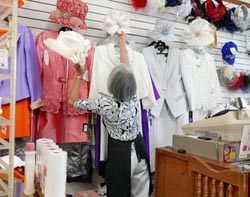
K relishes the freedom of having her own business. Over the years she has owned and operated Four Seasons, she has learned a lot about the culture of wearing hats and other apparel, about the occasions when people wear them, and how to provide the best customer service. Most of K's customers are African American. Among her European-American customers are members of the Red Hat Society, who shop for red and purple hats.
There are hats for every occasion. The Kentucky Derby has become a big hat-buying event in recent years. People either travel to Kentucky, carrying their hat boxes with them, or they attend Derby parties closer to home. Many of her customers come to buy hats for church. For special occasions, pastors' wives often seek out something fancy. In contrast, deaconesses wear white hats in a simpler pillbox style. Smaller hats and fascinators—which have been popular since the 2011 Royal Wedding—are worn to teas and bridal showers. People also tend to wear smaller hats to a funeral. Whatever the occasion, people match their outfits top to toe. Although she has absorbed a wealth of knowledge about her work and customers over the years, K continues to grow, observing, "Every day, I learn."



